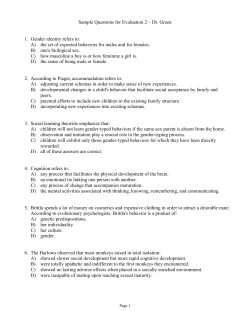
What is Sensory Integration? Touch Sense (Tactile) Touch Sense
What is Sensory Integration? Sensory integration helps people “make sense” of the world around them. Think of all the sensations you experience while dressing, bathing, walking, or riding a bike. Sensory integration is the process of using our senses to: Quickly take in sensory information Organize this information Use it for success in everyday activities We usually think of five senses: sight, sound, taste, touch, and smell. We also receive information from our body position sense (proprioception), and balance and movement sense (vestibular). Touch Sense (Tactile) The Tactile sense gives us information from our skin. Every time you touch something or are touched, your skin provides you with detailed information; this comes from the tactile sense. It allows you to tell the difference between a friendly touch from a peer and the feel of a bug on your arm. Body Position Sense (Proprioception) Proprioception is our body position sense. Proprioception is the ability to know where a body part is without having to look, and also helps us know how much pressure we need to do certain things. We use this sense when we pick up a paper cup filled with water without spilling or holding it too tightly. Touch Sense The tactile sense is helping this child lick ice cream off the cone, while not being bothered by the feel of it dripping on his hands. Body Position Sense Proprioception helps this child delicately hold the egg without crushing it. We all receive constant messages from our senses. Most people are able to use these messages to appropriately interact with their environment. Movement/Gravity Sense (Vestibular) Vestibular is our balance and movement sense. The vestibular sense allows us to move smoothly and balance while engaged in activities. We use this sense when riding a skateboard or sliding down a slide at the playground. Senses Unite Integrating information from the touch, proprioceptive, and vestibular systems, along with the other senses (sight, sound, taste, and smell), make it possible to successfully participate in everyday activities. Movement/Gravity Sense This child is using vestibular information to help her balance while walking on a curb. Tactile (touch) helps this boy hold the bat correctly. Proprioception (body position) helps him know his body is in the correct position. Vestibular (balance and movement) information helps him stay upright while coordinating his arm movements. His vision and hearing are also key to his success in the game. Some Possible Signs of Sensory Integration Issues: • Overly sensitive or under reactive to touch, movement, sights, or sounds in the environment • Unusually high or low activity level • Easily distracted; poor attention to tasks • Delays in speech, motor skills, or academic achievement • Coordination problems; appears clumsy or awkward • Poor body awareness • Difficulty learning new tasks or figuring out how to play with unfamiliar toys • Difficulty with tasks that require using both hands at the same time • Appears to be disorganized most of the time • Difficulty with transitions between activities or environments • Immature social skills • Impulsivity or lack of self-control • Difficulty calming self once “wound up” If you have concerns, contact your healthcare provider. Ask to schedule a full assessment so your child’s doctor can observe your child and address any concerns you may have. Be sure to keep a notebook for your concerns and observations. Share the notebook with the doctor or healthcare provider. Why Therapy is Important Therapy provides hope to families • Therapy can improve a child’s sensory processing and increase confidence, self-esteem, social participation, self-regulation, and overall skill development. Everyday tasks can be frustrating and tiring for children with sensory integration issues • Children may display different behaviors from day-to-day or moment-to-moment. An Introduction to Sensory Integration Therapists trained in sensory integration use a play-based and child-friendly approach • Children improve their ability to process and organize sensory information in a setting where the child can engage in a variety of fun sensory experiences. • Therapy can help kids simply be kids, playing alongside friends, and fully enjoying their young lives, while learning to respond to their sensory enviroment. For more sensory integration information and resources, visit www.pathways.org, select the “For Parents” tab, and click on “Sensory Integration.” You can also call Pathways at 800-955-CHILD (2445) or e-mail us at friends@pathways.org. COPY FREELY, DO NOT CHANGE, MUST ACKNOWLEDGE PATHWAYS © Copyright 2012 Photos by: Shay McAtee Since 1985, Pathways.org has used outcome-based research and multimedia as tools to promote each child’s fullest inclusion. We strive to empower health professionals and parents with knowledge of the benefit of early detection and early intervention for children’s sensory, motor, and communication development. Pathways.org is a 501(c)(3) Not-For-Profit
© Copyright 2025





















